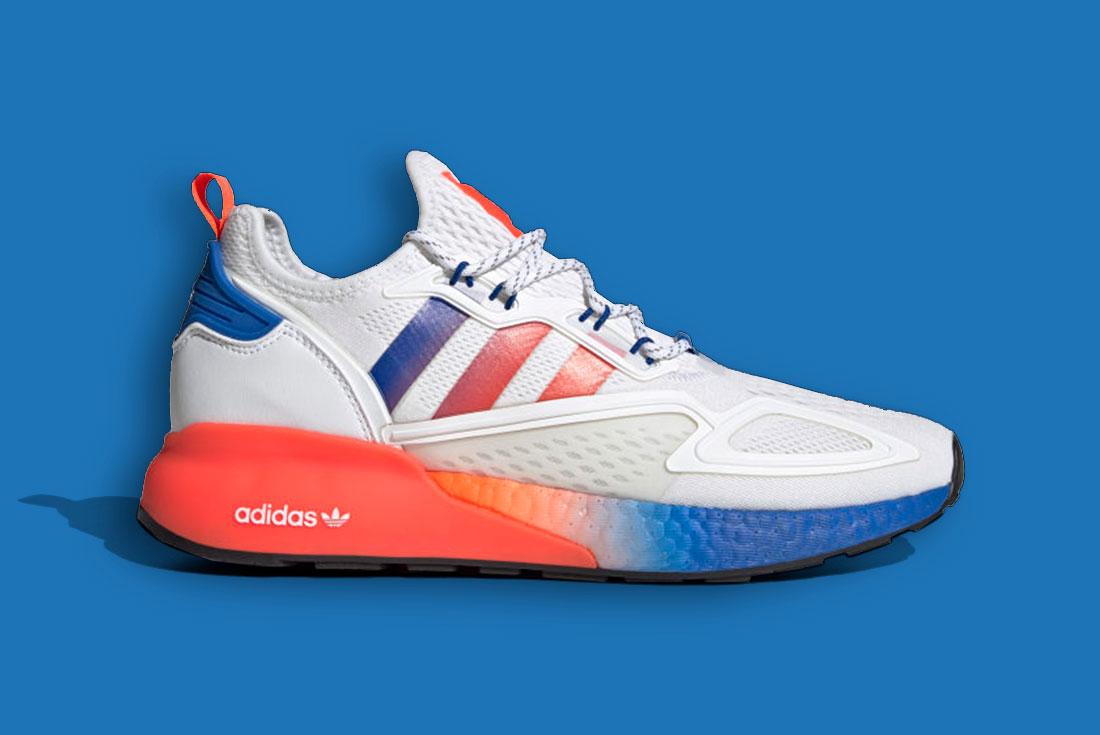Squishy ZXience: The adidas ZX 2K BOOST has Sole!
From the very first nail Adi Dassler hammered through a pair of running spikes in the 1920s, to the Torsion Bar-equipped ZX series that defined the brand in the 1980s, right through to today’s marshmallow-soft compound, history has been studded with soleful innovation. Now, the German powerhouse has revealed the latest destination in their quest for cosy.
The is the latest convergence of adidas sport and style, melding the utilitarian ethos of the ZX line with BOOST cushioning. However, this street machine is more than hybrid theory in action. It’s been built from the ground up with all of the hallmarks of any tech-laden runner flashing the ZX badge, albeit slightly detuned for street flexing. Let’s see where it gets all its ZX appeal from…
ZX 2K BOOST
While there are many subtle throwback design nods that will have adidas-heads seeing double, the ZX 2K BOOST is a legit adidas Original with decades of innovation crammed into its svelte silhouette.
The trademark ‘bootie-fit’ style of footwear construction was pioneered across the entire adidas spectrum throughout the 2010s. From the reimagined line to , and even the avant-garde ninja boots, the tongueless manifesto was warmly embraced within every category. The ZX 2K BOOST reprises that innate sense of comf but gives it a breezy facelift with fine-tuned mesh zones for targeted ventilation, along with welded TPU overlays. However, that’s as far as the surface-level similarities go. The ZX 2K BOOST rescinds the traditional external eyelets used on its predecessors and instead hotwires an integrated lacing system into the midfoot for a snugger fit.
The sporty upper is only half the story – underfoot is where the real action happens. Full-length BOOST soles provide endless comfort and they’re beefed up here with zigzagged TPU windows that wrap around the foot, keeping the squish factor up and the ride height down.
The colour and trim options we’ve seen so far on the ZX 2K BOOST are well judged touches. The model launched with direct homage to its inspo – a white and green combo lifted directly from the OG – but thankfully there are more than just retro throwback schemes for this new-gen wunderkind. Hyper colour highlights and monochromatic tones will suit any social or sporting occasion, but to fully appreciate the latest addition to the ZX family, let’s rewind the clock back to 1984.
40 Years of ZXience
In 1984, Jacques Chassaing and Markus Thaler were the dynamic duo behind the premier running line at adidas, working technological ZXience magic into the entire performance division. Cutting-edge innovation was at the forefront of the ZX design ethos. Early entries like the and ZX 710 (which provided the moodboard for the ZX 2K BOOST) are still perpetually underrated silhouettes in their retro cycles. By the tail end of the decade, the design team had really put ZX on the radar of hardcore runners.
1989 was a massive year for adidas. ZX nomenclature broke into the thousands with futuristic effect. Lodged between the and the , the remains one of the marque’s most iconic silhouettes. That vibrant ‘Aqua’ colourway drew attention to the technological textbook hiding within. Torsion Bar soles, Soft Cell cushioning and fancy compounds like the speedy-sounding Monza F1 rubber outsole added heft to the product descriptions. The class of 1989 was recently reunited in retro form to celebrate the big 3-0.
ZX continued to work in tandem with the Equipment (EQT) line through the 1990s and well into the 21st century, when the adidas Originals division began celebrating the brand’s throwback hits. It was under the Originals banner that former ZX flagships rejoined contemporary rotations, especially the legendary A-ZX collection from 2008 that celebrated so many old favourites. The imminent A-ZX Series that will roll-out across 2020-2021 will immortalise the nameplate once again.
Back in the mid-2010s, a new wave of retro-style joined the ZX family, but with appropriately modern nips and tucks. In 2014, the made a massive splash with sublimated graphic uppers that rendered the familiar ZX 8000 silhouette in a seamless package. Dozens of permutations later, the first official ZX/BOOST crossover occurred in 2015 on the aptly named . By this point, BOOST cushioning was on fire and converted sneakerheads wanted it where it matters most.
BOOST Vibes
For decades, sneaker midsoles remained largely unchanged. They were usually made from dense slabs of rubber, polyurethane (PU) or ethylene-vinyl acetate (EVA). While these materials underwent incremental improvements, they were ultimately a compromise between comfort and longevity. Back in 2013, BOOST completely revolutionised contemporary cushioning compounds.
Developed in conjunction with German material experts BASF, the material was developed from pellets of expanded thermoplastic polyurethane (eTPU). With its superior shock absorption and energy return properties, the adidas Innovation Team fine-tuned eTPU into the familiar, cluster-like form seen today.
The revolutionary tech was rolled out on the Energy BOOST and adiZero adios BOOST, and immediately proved its mettle by winning the 2014 Berlin Marathon, setting a new world record in the process. Crossover appeal was unleashed with the introduction of in 2015. co-sign aside, the guarantee of instant comfort and easy-on-the-eyes aesthetics made it an instant classic. The BOOST vibes continued with the equally audacious NMD, the launch of the series and various reworks of Three Stripe classics. Today, the ZX 2K BOOST is writing the next chapter of the constantly evolving BOOST story.
ZX Next
The ZX 2K BOOST is an exciting glimpse into the future of ZX. As adidas find new ways to simultaneously celebrate comfort while also delivering a healthy nod to their 70 years of heritage, there will be plenty more to come from the ZXience lab.
Experience 40 years of ZXience in the ZX 2K BOOST today by scooping up a pair directly from or
